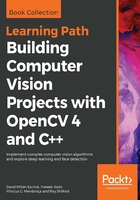
Inbuilt data structures and input/output
One of the best things about OpenCV is that it provides a lot of in-built primitives to handle operations related to image processing and computer vision. If you have to write something from scratch, you will have to define Image, Point, Rectangle, and so on. These are fundamental to almost any computer vision algorithm.
OpenCV comes with all these basic structures out of the box, contained in the core module. Another advantage is that these structures have already been optimized for speed and memory, and so you don't have to worry about the implementation details.
The imgcodecs module handles reading and writing of image files. When you operate on an input image and create an output image, you can save it as a .jpg or a .png file with a simple command.
You will be dealing with a lot of video files when you work with cameras. The videoio module handles everything related to the input and output of video files. You can easily capture a video from the webcam or read a video file in many different formats. You can even save a bunch of frames as a video file by setting properties such as frames per second, frame size, and so on.